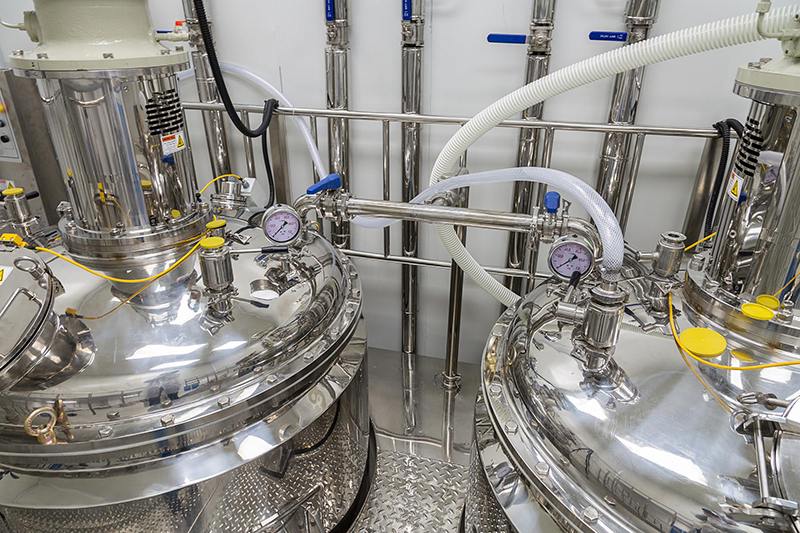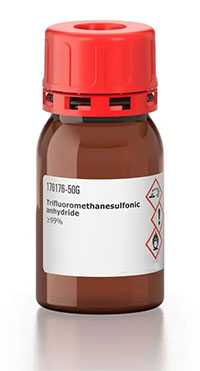Trifluoromethanesulfonic anhydride (Tf₂O), also known as triflic anhydride, is a highly reactive and versatile chemical compound widely employed in synthetic organic chemistry.As the acid anhydride of trifluoromethanesulfonic acid (triflic acid, CF₃SO₃H), it is a potent electrophile capable of introducing the trifluoromethylsulfonyl (triflyl) group into a variety of substrates. This colorless to light brown liquid, with a boiling point around 81-84°C at atmospheric pressure, serves as a crucial reagent in the formation of triflates from alcohols and ketones, the activation of carbonyl compounds, and as a catalyst in numerous chemical transformations. Its applications are diverse, spanning the synthesis of complex molecules in the pharmaceutical, agrochemical, and advanced materials industries.

The reliability of experimental outcomes in these diverse applications hinges on the purity of the trifluoromethanesulfonic anhydride used. Impurities, such as triflic acid, which is commonly encountered, can interfere with the intended reactions, leading to reduced yields, the formation of undesired byproducts, or even completely misleading results. High purity is therefore not merely desirable but absolutely essential for quantitative studies demanding precise measurements and for the synthesis of delicate compounds where even trace contaminants can have significant and detrimental effects. The presence of even small amounts of triflic acid, a strong acid with a pKa of -13.6, can drastically alter the reactivity of Tf2O due to its inherent acidic nature, necessitating rigorous purification protocols to ensure the integrity of experimental results.
Trifluoromethanesulfonic anhydride is commonly synthesized via the dehydration of triflic acid, with phosphorus pentoxide (P₂O₅) being the most frequently employed dehydrating agent.1 This reaction yields Tf₂O and phosphoric acid as the primary products. Other synthetic routes include the reaction of trifluoromethanesulfonate salts with trifluoromethanesulfonyl fluoride, often catalyzed by amines, and reactions involving phosphorus pentachloride (PCl₅) or a combination of phosphorus trichloride (PCl₃) and chlorine gas (Cl₂). Additionally, the formation of mixed anhydrides with carboxylic acids followed by disproportionation has also been reported as a method for Tf₂O synthesis. The variety of synthetic routes suggests that the initial impurity profile can differ depending on the method used, highlighting the need for adaptable purification strategies.
A widely established laboratory protocol for purifying trifluoromethanesulfonic anhydride involves the reaction of triflic acid with phosphorus pentoxide, followed by distillation.1 In this method, triflic acid reacts with P₂O₅ to form Tf₂O and phosphoric acid. The balanced equation for this reaction is 6 CF₃SO₃H + P₂O₅ → 3 (CF₃SO₂)₂O + 2 H₃PO₄. The crude product is then distilled to separate Tf₂O from the higher-boiling phosphoric acid and any unreacted triflic acid. Research has shown that this two-step process, involving the reaction with P₂O₅ to reduce triflic acid content followed by vacuum batch distillation, can yield Tf₂O with a purity of 99.5% and a yield of 70%. A detailed procedure involves reacting triflic acid and P₂O₅ at room temperature for at least 3 hours, followed by distillation at 82-115°C to obtain crude Tf₂O in 83-91% yield. A second purification step, stirring the crude anhydride with phosphorus pentoxide for 18 hours followed by redistillation at 81-84°C, is often recommended to obtain pure Tf₂O. The consistency of this protocol across multiple sources indicates its reliability for obtaining trifluoromethanesulfonic anhydride.
Variations in these protocols exist to optimize yield and purity. Premixing P₂O₅ with Celite is suggested to improve handling and yield. Vacuum distillation is frequently preferred for the final purification to lower the boiling point and minimize decomposition. One patent describes a method using trifluoromethanesulfonate and trifluoromethanesulfonyl fluoride with a 4-dialkyl aminopyridine catalyst, claiming high yield (>90%) and purity (>99 wt%). Another approach involves using an excess of triflic acid over P₂O₅ to prevent the reaction mixture from hardening due to polyphosphoric acid byproduct, potentially improving efficiency. These variations highlight ongoing efforts to refine the synthesis and purification of Tf₂O.
Summary of Established Purification Protocols for Trifluoromethanesulfonic Anhydride
| Protocol Description | Key Steps | Reported Yield Range (%) | Reported Purity (%) | Distillation Conditions (Temperature °C / Pressure) | Snippet ID(s) |
| TfOH + P₂O₅ followed by distillation | Reaction of triflic acid with P₂O₅ at room temp, distillation | 83-91 (crude) | - | 82-115 / Atmospheric | 1 |
| TfOH + P₂O₅ followed by P₂O₅ treatment and redistillation | Reaction, distillation, stirring with P₂O₅, redistillation | - | - | 81-84 / Atmospheric | 1 |
| TfOH + P₂O₅ followed by batch vacuum distillation | Reaction, batch vacuum distillation | 70 | 99.5 | - / Vacuum | 12 |
| Trifluoromethanesulfonate + Tf₂SO₂F (catalytic) | Reaction of triflate salt with Tf₂SO₂F using amine catalyst | >90 | >99 wt% | 40-80 / Reduced pressure (-0.05 to -0.08 MPa) | 8 |
| Excess TfOH + P₂O₅ followed by distillation | Reaction with excess TfOH to prevent hardening, distillation | - | - | Reduced pressure | 10 |
Distillation is a fundamental technique for purifying trifluoromethanesulfonic anhydride, relying on the differences in boiling points between Tf₂O and its impurities. For effective separation, a sufficient difference in boiling points is necessary. Vacuum distillation can be employed to lower the boiling point, which is advantageous for thermally sensitive compounds.The success of distillation depends on the vapor pressure differences between Tf₂O and its contaminants, and careful control of temperature and pressure is essential.
The first distillation of the reaction mixture (triflic acid + P₂O₅) is typically performed between 82–115°C. Redistillation of the crude anhydride, often after treatment with P₂O₅, is conducted at a narrower range of 81–84°C. A forerun with a boiling point of 74–81°C may be collected during the second distillation. While most protocols describe atmospheric distillation (around 760 torr), with Tf₂O boiling at 81-84°C, batch vacuum distillation is also used to achieve higher purity (99.5%). In an alternative synthesis, Tf₂O is collected under reduced pressure (-0.05 to -0.08 MPa) at 40-80°C after atmospheric distillation of excess trifluoromethanesulfonyl fluoride.8 Reduced pressure distillation at 1.333 kPa (10 torr) and up to 200°C has been used to recover unreacted triflic acid after recovering Tf₂O under vacuum.
Short-path distilling heads are commonly recommended to minimize exposure to the atmosphere and reduce losses. A short Vigreux column is also suggested. The apparatus must be meticulously dry and assembled under an inert atmosphere (e.g., nitrogen or argon) to prevent hydrolysis. Ground-glass joints should be well-sealed, using Teflon sleeves or chlorofluorocarbon stopcock grease if necessary. The nitrogen outlet should be well vented.
Practical distillation steps involve direct distillation of crude Tf₂O or pre-treatment with a small amount of P₂O₅ (3-5 wt%) for 3-18 hours at room temperature under anhydrous conditions before redistillation. Adding a small amount of Tf₂O to the distillation flask beforehand can scavenge residual water or triflic acid.Distillation should be slow, collecting the fraction at 81-84°C (atmospheric pressure) as pure Tf₂O and discarding any forerun. The distillation should be stopped before the pot temperature rises significantly.
Potential pitfalls include hydrolysis due to moisture, which necessitates dry glassware and an inert atmosphere. Overheating can cause decomposition, making vacuum distillation preferable. The close boiling points of Tf₂O and some impurities (e.g., POCl₃) can make separation difficult. Solidification of the reaction mixture (with P₂O₅) can hinder distillation; using excess triflic acid or premixing P₂O₅ with Celite can help. Flask breakage at high temperatures can occur, so gradual heating and cooling are recommended.
Several methods can be employed to assess the purity of trifluoromethanesulfonic anhydride. 19 F NMR spectroscopy is particularly useful for detecting the presence of trifluoromethanesulfonic acid (triflic acid) as an impurity. Tf₂O typically shows a chemical shift around -72.6 ppm, while triflic acid appears around -77.3 ppm (relative to CFCl₃). The integration of these peaks allows for quantification of the impurity level. Gas Chromatography (GC) analysis can identify and quantify volatile impurities, revealing the presence of a major peak for Tf₂O and potentially minor unidentified impurities that redistillation can remove. GC coupled with mass spectrometry (GC-MS) can aid in identifying these unknown impurities. Infrared (IR) spectroscopy can confirm the presence of characteristic functional groups, with strong absorptions observed at 1470, 1240, and 1130 cm⁻¹ for pure Tf₂O. Chemical methods, such as titration, can determine the acid content. Hydrolyzing Tf₂O with methanol to form triflic acid followed by titration with NaOH can indicate purity. Pure Tf₂O should yield two moles of triflic acid per mole of anhydride.
Purity is typically expressed as a percentage, often determined by GC or NMR. Commercial Tf₂O often has a purity of >98% or >99%. Acceptance criteria depend on the intended application, with higher purity often required for sensitive reactions. The minimal presence of triflic acid is usually a key indicator of good quality. Defining clear purity criteria based on analytical methods is essential for quality control.
The purification of trifluoromethanesulfonic anhydride is typically achieved through the dehydration of triflic acid with phosphorus pentoxide, followed by careful distillation, often with a second P₂O₅ treatment. Distillation should be performed using dry glassware under an inert atmosphere, with the fraction boiling at 81-84°C (atmospheric pressure) considered the purest. Vacuum distillation is an alternative, especially for heat-sensitive applications. Purity should be verified using 19F NMR, GC, IR spectroscopy, and titration. Handling requires strict safety protocols and appropriate PPE, including butyl rubber gloves, safety goggles, a face shield, and a fume hood. Tf₂O must be stored in tightly sealed containers under anhydrous and inert conditions, away from heat and combustibles, preferably refrigerated. Disposal must follow local and national regulations for hazardous waste. Stabilizers are not common; long-term stability relies on proper storage. Due to its hazardous nature, all procedures must be performed with extreme caution, and verifying purity is essential for reliable experimental results.
The purification of trifluoromethanesulfonic anhydride is typically achieved through the dehydration of triflic acid with phosphorus pentoxide, followed by careful distillation, often with a second P₂O₅ treatment. Distillation should be performed using dry glassware under an inert atmosphere, with the fraction boiling at 81-84°C (atmospheric pressure) considered the purest. Vacuum distillation is an alternative, especially for heat-sensitive applications. Purity should be verified using 19F NMR, GC, IR spectroscopy, and titration. Handling requires strict safety protocols and appropriate PPE, including butyl rubber gloves, safety goggles, a face shield, and a fume hood. Tf₂O must be stored in tightly sealed containers under anhydrous and inert conditions, away from heat and combustibles, preferably refrigerated. Disposal must follow local and national regulations for hazardous waste. Stabilizers are not common; long-term stability relies on proper storage. Due to its hazardous nature, all procedures must be performed with extreme caution, and verifying purity is essential for reliable experimental results.

Contact: Tony Li
Phone: +86-13263299644
Tel: +86-13263299644
Email: sales@ecoviaet.com
Add: No 3 Youyi Road,Tangshan,Huantai,Zibo,China
We chat
